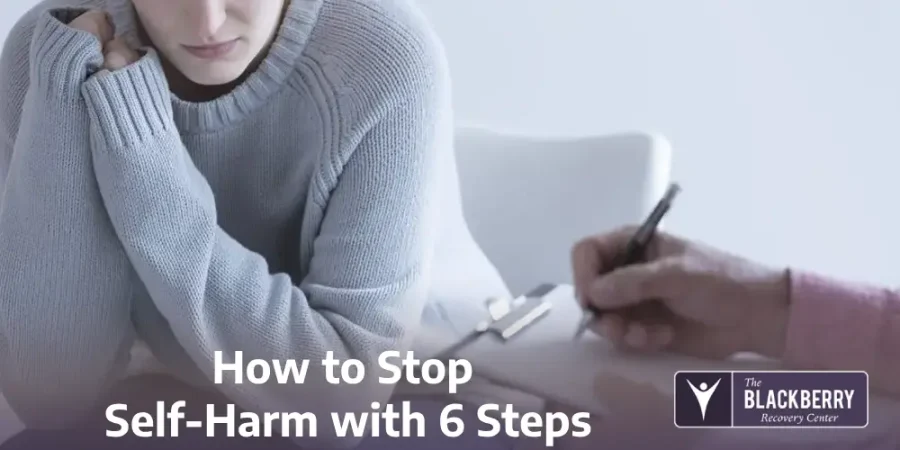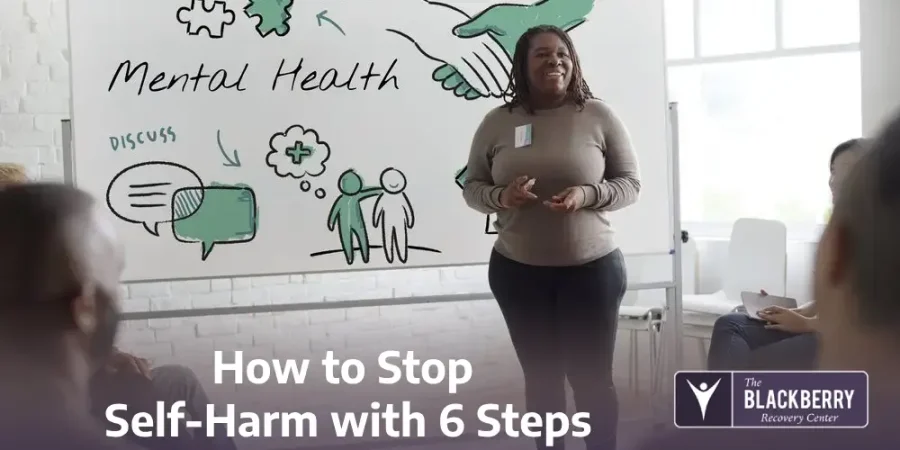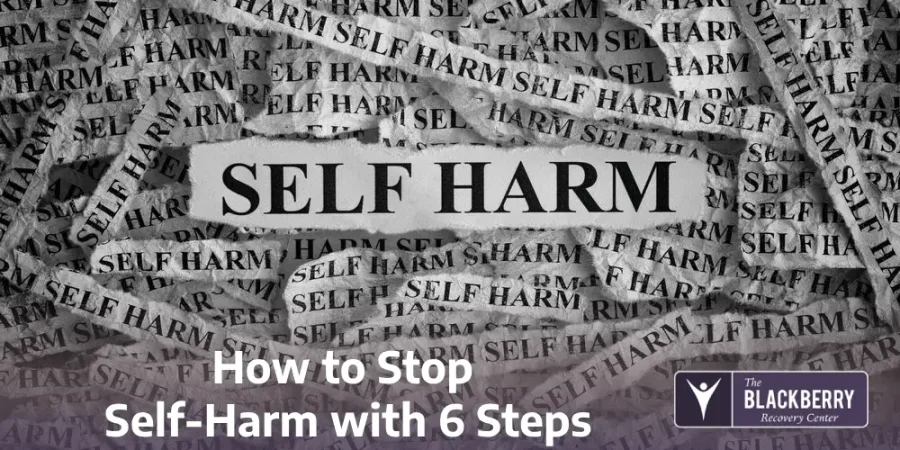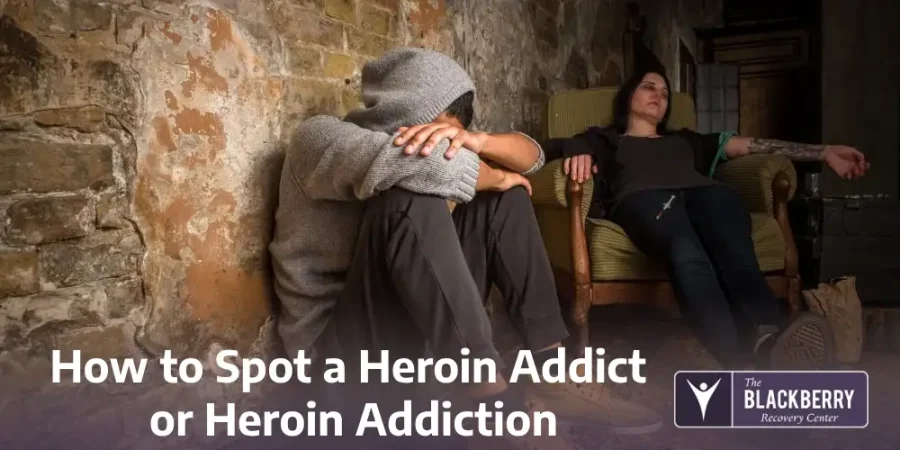Learning how to stop self-harm starts with these tips. Find out more on self-harm recovery as well as how The Blackberry Center can help you stop self-harming behaviors for good.
Treating Self-Harming Behaviors
Learning how to stop self-harm is important, but that doesn’t mean it’s easy. For many people who self-harm, it can feel incredibly difficult to quit.
Self-harming behaviors are especially difficult to talk about for people who self-harm because they can feel embarrassing. You may also want to avoid disappointing the people around you, which increases feelings of shame.
Although self-harming behaviors can seem like a way to deal with stress, anxiety, and emotional pain, they only provide temporary relief. Without dealing with the underlying emotions that are causing the behavior, you’ll continue harming yourself, which can lead to dangerous injuries and increased mental health issues.
At The Blackberry Center, we know how to stop self-harm behaviors, and we do it in an atmosphere that makes you feel comfortable with your mental health challenges, whatever they may be.
Here are a few tips we suggest when learning healthier ways to deal when you’re feeling the urge to self-harm.
1. Find Someone Who Can Help

How to Stop Self-Harm with 6 Steps – Blackberry
The first thing you should do is find someone who can help. Sometimes, that means reaching out to a friend or family member. It often also includes reaching out to a mental health professional who has experience working with people who engage in harming behaviors.
When you do reach out to a mental health professional, you’ll likely participate in cognitive behavioral therapy. This type of therapy is similar to traditional talk therapy, but it focuses on identifying the cognitive distortions that may be causing you to harm yourself. It is a great way to get to the root of your self-harming behavior so you can find healthier ways to deal with your emotions.
2. Consider Different Kinds of Therapy
Sharing your struggles with someone is a great way to get the support you need when you find it difficult to stop harming yourself, especially if it involves talking with a therapist who uses cognitive behavioral therapy during your sessions. But that doesn’t mean it’s your only option.
There are a lot of therapy options for those who are using methods of self-harm as coping mechanisms to deal with life stresses. Just a few include:
- Group therapy
- Family therapy
- Trauma therapy
- Recreational therapy
Having the option to participate in different kinds of therapy often leads to diagnoses of disorders that accompany self-harm behaviors. Therapy can address co-occurring disorders, like eating disorders, personality disorders, and substance abuse disorders, which in turn can reduce your urges to harm yourself.
3. Get Rid of Items You Use to Self-Harm
The are many ways to self-harm. The urge to cut is common, but many people who self-harm also use items around the house, such as snapping a rubber band, stabbing safety pins, lighting matches, and more. No matter what you use when coping with life stresses, it’s important to get rid of these items to reduce temptation.
This is why reaching out to loved ones is so important. Friends and family can help you get rid of seemingly innocent household items to help you cope with the urge to self-harm.
4. Find Something Else to Do When You Get the Urge to Self-Harm
If you’ve had a chance to go to therapy, you will be able to identify triggers that make you want to self-harm. When those triggers appear, or you start to feel the urge to cut, you can find something else to do instead.
There are many things to choose from. Just a few ideas include:
- Listen to music
- Do a household chore, like wash the dishes
- Go for a walk or a run
- Call or text a trusted friend
- Hold something in your hand
It’s all about finding something that works for you in your unique situation. Cleaning the bedroom might work for you, while getting out into nature may work to calm someone else’s nerves.
5. Learn How to Let out Your Emotional Pain in a Healthy Way
Self-harm isn’t a formal diagnosis in the DSM-5, which means it isn’t recognized as an actual mental health disorder. Instead, self-harm is considered to be a coping mechanism to deal with overwhelming emotions. It is often present with other mental health disorders, but it does not have its own diagnosis.
The good news is that for most patients who use self-harm as a coping strategy, other methods of dealing with emotions can eliminate the problem.
Screaming and yelling can be surprisingly effective ways to deal with certain emotions, while asking for a hug can help you deal with others. There is absolutely nothing to be ashamed of when crying, especially since it actually works to help you feel comfortable in triggering situations.
6. Consider an Inpatient Treatment Program

How to Stop Self-Harm with 6 Steps – Blackberry Center
If your harming behavior is getting worse, or if it’s something you’ve been doing in the long-term to deal with tough emotions, it’s time to take a more serious approach to learning how to stop self-harm. That could mean a stay in an inpatient treatment program.
Inpatient programs can prevent you from harming yourself as you learn healthier ways to deal with your emotions. They are especially effective if you’re beginning to have suicidal thoughts, or if you’re dealing with other mental health disorders.
The Blackberry Center is here to help you with all the tips on this list and more. We will cater a therapy program for your specific needs so you can eliminate the urge to self-harm for good.
Call us directly at (813) 908-4199, or fill out our online form and we can tell you more about our treatment options.
Video
Understanding Non-Suicidal Self-Injury
When a person inflicts self-injury but doesn’t want to end their life, it’s called Non-Suicidal Self-Injury. This can be a sign of psychological or emotional distress.
Podcast
The Psychology of Self-Injury: Exploring Self-Harm & Mental Health
Why do people self-injure? And what is the best way to respond when someone tells us they self-injure? Dr. Nicholas Westers, a clinical psychologist at Children’s Health and Associate Professor at the University of Texas Southwestern Medical Center, collaborates with the International Society for the Study of Self-Injury (ISSS) to interview the leading experts in the field of self-injury and self-harm as well as individuals with lived experience of self-injury and parents and family members of those who have self-injured. This podcast is meant to be a resource for parents, professionals, and people with lived experience.
Why Do People Self-Harm
In this episode, I’m exploring why people self-harm. If we don’t understand the reasons underlying self-harm, it’s very to move towards healthier coping mechanisms.
FAQ
- What are effective first steps to stop self-harming?
Acknowledge the urge, reach out for support, and identify underlying triggers. - How can someone identify their triggers for self-harm?
Reflect on patterns in emotions, environments, or stressors leading to self-harm urges. - Are there alternative coping mechanisms to replace self-harm?
Yes, strategies like journaling, mindfulness, or using safe distractions can help. - How can loved ones support someone trying to stop self-harming?
Offer non-judgmental support, listen actively, and encourage professional help. - Is professional therapy necessary to stop self-harm?
While personal efforts help, therapy is highly recommended for lasting recovery.






